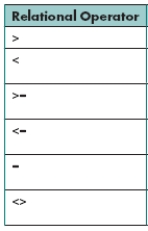Multiple Choice
Case-Based Critical Thinking Questions
Case 2-1

Julia is learning how to use relational operators with the COUNTIF function. Her boss handed her the chart in the above figure and asked her to solve some everyday business problems.
-On a separate project, the head of Human Resources is looking for a list of people who do not have 100% attendance. In the database, the number 1 means 100% attendance; all other numbers indicate that some work was missed (for example, .75 is 75% attendance) . The data is listed in column E of a worksheet. The correct COUNTIF formula would be ____.
A) =COUNTIF(E3:E13,"<>1")
B) =COUNTIF(E3:E13,"=1")
C) =COUNTIF(E3:E13,">=1")
D) =COUNTIF(E3:E13,"<1")
Correct Answer:

Verified
Correct Answer:
Verified
Q20: In the SMALL function, the first argument,
Q21: The MODE.SNGL, MEDIAN, and STDEV.S functions work
Q22: The Paste Special dialog box offers the
Q23: The _ symbol(s) insert(s) a comma as
Q24: The _ is the arithmetic value that
Q26: Excel uses the Goal Find tool to
Q27: A(n) _ distribution exhibits an equal number
Q28: Wingdings are symbols that you can use
Q29: Selecting the Set precision as displayed workbook
Q30: The ADDIF function adds all the values